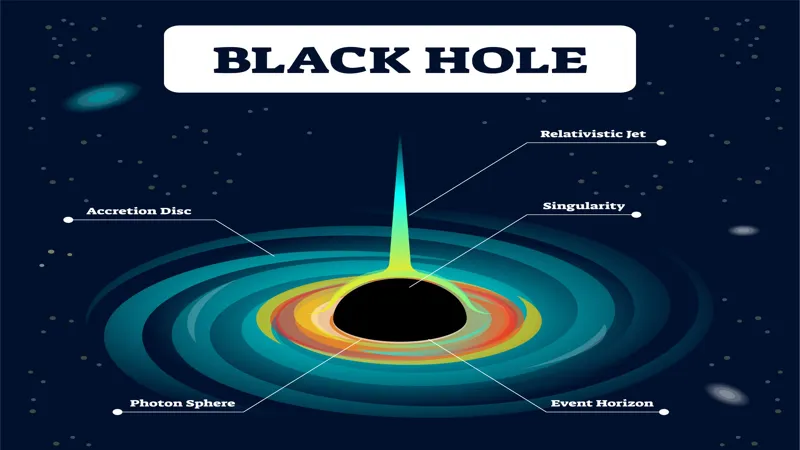Black holes have long captivated the imagination, often depicted as cosmic monsters lurking in the shadows of space, ready to consume anything that dares to venture too close. However, the truth about these enigmatic entities is far more complex and fascinating than popular culture suggests. While they are indeed regions of intense gravitational pull, misconceptions abound regarding their nature, behavior, and origins. In this exploration, we will delve into the realities of black holes, debunking common myths and illuminating the remarkable science that reveals these extraordinary phenomena in a new light.
| Common Belief | Fact |
|---|---|
| Black Holes Are Cosmic Vacuum Cleaners | They don’t suck everything randomly; objects can orbit them safely unless they cross the event horizon. |
| Black Holes Are Completely Invisible | They can be detected by observing the effects on nearby matter, such as glowing accretion disks. |
| All Black Holes Are the Same Size | Black holes vary in size: stellar-mass, intermediate-mass, supermassive, and theoretical primordial black holes. |
| All Stars Become Black Holes | Only the largest stars (about 20 times the mass of the Sun) can collapse into black holes; smaller stars become white dwarfs or neutron stars. |
| You’d Be Instantly Crushed Upon Entering a Black Hole | The experience varies: in smaller black holes, you stretch (spaghettification), while in supermassive ones, the pull is gradual. |
| Black Holes Are Permanent | They can shrink and evaporate over time due to Hawking radiation, but nothing escapes once inside the event horizon. |
| Black Holes Stay in One Place | They can move through space, with some drifting like rogue black holes. |
| Black Holes Are Just Holes in Space | They are super-dense objects with significant mass and gravity, not empty voids. |
| The Large Hadron Collider Could Create a Black Hole That Destroys Earth | Any tiny black holes created would evaporate quickly and pose no threat to Earth. |
Understanding Black Holes: A Cosmic Mystery
Black holes are some of the most mysterious objects in space. They form from the collapse of massive stars, creating a region where gravity is so strong that nothing can escape it. This makes them fascinating to scientists and curious minds alike. Although they are invisible, their effects can be seen on nearby stars and gas, which helps us learn more about them.
Scientists have dedicated their careers to understanding black holes. They use powerful telescopes and advanced technology to study how black holes affect their surroundings. For example, when a black hole pulls in gas, it creates light and heat that can be detected from Earth. This way, we can learn more about these cosmic phenomena even though we can’t see them directly.
Frequently Asked Questions
What are black holes?
Black holes are super-dense objects in space with strong gravity. They form when massive stars collapse, creating a region where nothing, not even light, can escape.
Can anything escape a black hole?
No, once something crosses the event horizon of a black hole, it cannot escape. However, black holes can gradually lose energy over time due to Hawking radiation.
Do black holes suck in everything around them?
No, black holes don’t randomly attract objects. Things can orbit them safely, but if they come too close, they risk being pulled in by strong gravity.
Are all black holes the same size?
No, black holes vary in size. They can be stellar, intermediate, supermassive, or even theoretical primordial black holes, ranging from small to billions of times the Sun’s mass.
Can black holes be seen?
Black holes cannot be seen directly, but scientists detect them by observing their effects on nearby matter, such as gas and dust that emit bright light when heated.
What happens if you fall into a black hole?
Falling into a black hole can be different depending on its size. Smaller ones may stretch you out, while larger ones might not show immediate effects until it’s too late.
Can humans create black holes?
While there are theories about creating tiny black holes in particle accelerators, they would be too small to harm Earth and would disappear quickly, posing no real danger.
Summary
Black holes are fascinating cosmic objects, but many common beliefs about them are incorrect. They are not cosmic vacuum cleaners that suck everything in; instead, objects can safely orbit around them if they stay at a safe distance. Black holes are invisible because they don’t emit light, but scientists can detect them by observing the hot gas and dust swirling around them. They vary in size and not all stars become black holes; only the largest ones do. While crossing their event horizon means no return, black holes can slowly shrink and are not permanent. They are dense objects, not just holes in space.
